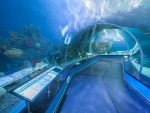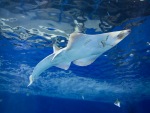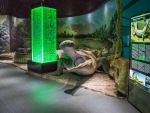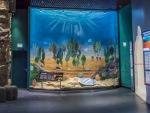Exhibits
The Evolution of Life in the Ocean exhibit allows visitors to move 4.6 billion years back in time to the beginning of the Solar System and to learn about modern theories of Earth’s history, formation of the World Ocean, and the origin of life on our planet.
Plenty of models, multimedia devices, and information stands help to imagine the landmark events as well as to see pictures and fossils of extinct organisms that lived in different geologic periods.
The Microworld exhibit reveals an amazing world that is invisible to a naked human eye but forms the base of all food chains in the ocean and determines the existence and stability of marine ecosystems.
Visitors can see not only enlarged models of the microscopic organisms but a whole universe in a water drop using a light microscope. They can also learn how an electron microscope works and thus to examine the external appearance of the smallest creatures in tiniest details.
Aquatic Regions of Russia
The Rivers and Lakes exhibit introduces visitors to a variety of natural landscapes, animals, and plants of the Amur River basin. Murals and video walls display picturesque sceneries and inhabitants of lakes Khanka and Baikal.
The Amur River is one of the world’s largest waterways with the biggest basin among all rivers running into the Pacific Ocean. Flowing through the territories of three countries - Russia, China, and Mongolia - the Amur River crosses the landscapes of four geographic zones such as semi-deserts, steppes, forest-steppes, and forests. The fish fauna of the Amur is the most diverse in Russia: the river supports about 150 fish species including one of the world’s biggest freshwater fish – the kaluga.
Khanka is the largest lake in the Russian Far East. The lowlands surrounding the lake are East Asia’s biggest wetlands that give shelter to hundreds of thousands birds. The basin of lake Khanka is the only place in this country where 378 bird species are found, with 55 of them listed in the Red Data Book of Russia.
Baikal is the world’s deepest lake and the largest reservoir of pure fresh water. The lake is known for a unique flora and fauna and houses 2,600 animal species, more than half of which are endemic to Baikal and occur only here.
The Polar World exhibit recreates the atmosphere of the Arctic and Antarcticа, shows the uniqueness of their wildlife, narrates the role Russia has played in the exploration of high latitudes and acquaints the public with heroic deeds of polar pioneers.
Here visitors can watch two films: one of them shows the submersible Mir performing a dive in the Arctic Ocean, and the other tells about animals inhabiting the South Pole. The exhibit also showcases models of some polar exploration vessels – from a koch boat to Russian nuclear-powered icebreakers.
The Bering Sea and Sea of Okhotsk exhibit introduces visitors to highly productive seas providing the bulk of the fish and seafood caught in the Russian Federation.
The deepest and biggest in Russia, the Bering Sea is a home for 400 fish species. Finbacks, humpback and sei whales along with blue, bowhead, and gray whales forage in its vast expanses. Rookeries of walruses, sea lions, and fur seals spread along the seashore. Coastal algal beds host the sea otter, who, not long ago, narrowly escaped extinction caused by overhunting for its fur.
The Sea of Okhotsk is the most biologically productive marine ecosystem in Russia. It supports a diverse array of animal life, including some 300 species of fishes, the most numerous populations of the red and blue king crab, bivalves and gastropods. The sea also has huge resources of valuable sea grasses and algae. At the same time, active production of oil and gas currently takes place on the Sea of Okhotsk shelf. That is why maintaining a reasonable balance to protect the ocean life is one of the high-priority tasks of wise environmental management.
This exhibit is a home to northern fur seals, and visitors can watch them gracefully moving and joyfully playing in their pool.
The core of the exhibit is a giant Kelp Forest tank housing various species not only of seaweed but also of fish that inhabit kelp forests in the wild.
The Sea of Japan/East Sea exhibit tells about warm and cold ocean currents giving rise to the sea’s wealth and species abundance, which is the highest among the seas of the Russian Far East. Of 1,170 fish species known from the Sea of Japan, 365 species live in Russian waters.
The exhibit puts emphasis on Peter the Great Bay washing the southern part of Primorye Territory and features the most fantastic members of the bay fauna.
The separate part of the exhibit displays marine organisms named after mythological creatures, gods, and heroes. Sculptures and sophisticated technologies used in this educative and entertaining section allow visitors to see mythic characters and learn what they and marine inhabitants bearing their names have in common. A fascinating dance of jellyfish concludes the exhibit.
Aquatic Regions of the World
The Tropical Rain Forest exhibit creates an impression of being in the equatorial forest with its moist air, specific sounds, and a waterfall. Visitors can admire liana-entwined trees surrounded by various epiphytes and colourful orchids at close range and have an opportunity to observe Amazonian fishes along with tropical forest amphibians, reptiles, arthropods and insects living here. The exhibit shows amazing beauty, peculiarities and biodiversity of different layers of the tropical rain forest.
The Tropical Seas exhibit enables visitors to closely view tropical marine life and shows wonderful sceneries of coral reefs as well as various species and shapes of corals.
The transparent tunnel with a moving walkway leads visitors through a huge tank hosting colourful coral fishes, predatory moray eels, and other dwellers of this fascinating and mysterious world of coral reefs.
Thematic films will help guests to learn a lot about the structure and diversity of reefs and to get familiar with the lifestyle and reproduction of coral polyps that are great architects of the ocean.
The Ocean Abyss exhibit is placed in one of the Aquarium’s largest tank containing some 3,000 tons of water held up by the 36-cm thick acrylic glass. The exhibit creates a peaceful atmosphere of calm ocean depths with slowly moving fishes of different shapes and colours.
Majestic sharks, rays, and pelagic schooling fish can be seen through the glass here. The sense of immersion is deepened when a visitor gets into a transparent acrylic capsule “soaring” in the water and watches huge fishes - wanderers of the open ocean - drifting at arm’s length.













